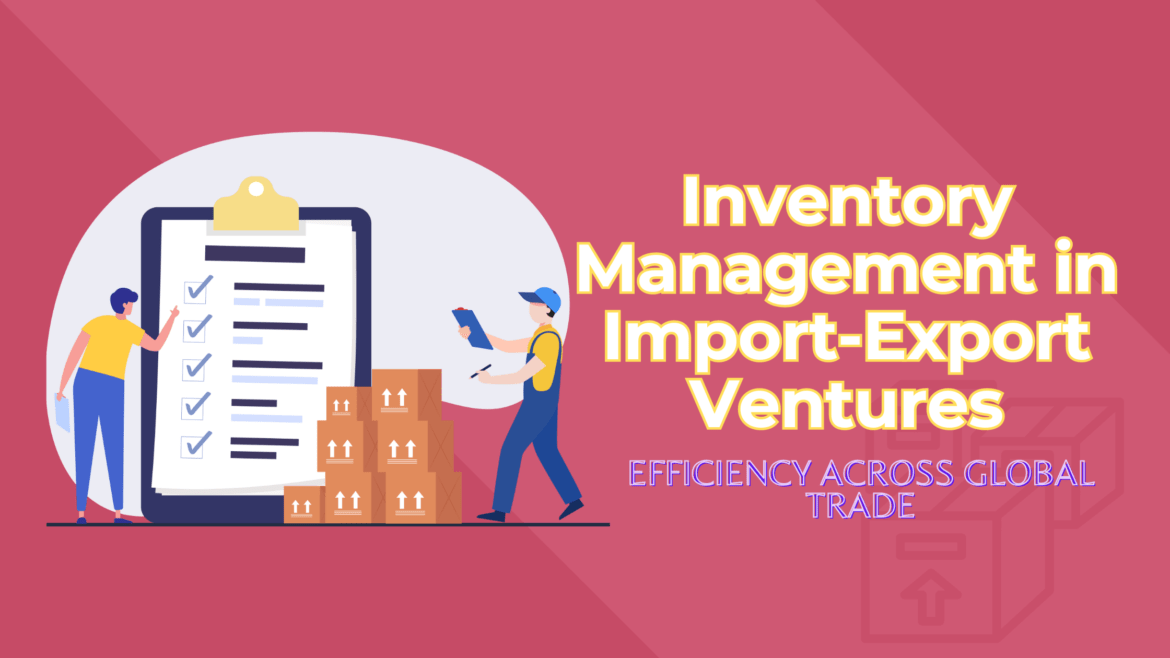Inventory management is a pivotal aspect of import-export ventures that can significantly impact operational efficiency and profitability. Effectively managing inventory ensures a seamless flow of goods, prevents stockouts or overstocking, and enhances customer satisfaction. The complexity of inventory management in import-export businesses highlights its importance, challenges, and strategies to achieve mastery in this critical domain.
Understanding Inventory Management in Import-Export Ventures
1. The Significance of Inventory Management
Inventory management involves the careful control and oversight of the goods held by a business. For import-export ventures, efficient inventory management is essential to meet customer demands, optimize costs, and maintain a competitive edge.
2. Types of Inventory
In import-export ventures, there are three primary types of inventory:
a. Raw Materials:
These are the materials used to produce goods. Effective management ensures a smooth production process and minimizes delays.
b. Work-in-Progress (WIP):
WIP inventory includes goods in the process of being manufactured or assembled. Proper management ensures timely completion of production cycles.
c. Finished Goods:
These are the final products ready for sale. Proper inventory management of finished goods prevents overstocking or stockouts.
Challenges in Inventory Management
1. Demand Variability
Demand for imported and exported goods can be influenced by various factors such as changing consumer preferences, economic conditions, and geopolitical events. To address demand variability:
- Use Historical Data: Analyze past sales data to identify patterns and trends in demand. This can help you make more accurate forecasts for future demand.
- Market Research: Stay updated on market trends, customer preferences, and industry developments. This information can guide your inventory decisions.
- Collaborate with Suppliers: Establish open communication channels with suppliers to share demand forecasts. This enables them to adjust their production schedules accordingly.
2. Lead Times
The longer lead times in international trade can pose challenges for inventory management. To manage lead times effectively:
- Buffer Stock: Factor in the extended lead times when calculating your order quantities. Maintain buffer stock to bridge the gap between placing an order and receiving it.
- Expedited Shipping: Consider using expedited shipping methods for critical inventory to reduce lead times. However, balance the cost of expedited shipping with the benefits of quicker delivery.
3. Currency Fluctuations
Currency fluctuations can impact the cost of imported goods, affecting both the cost of goods sold (COGS) and the value of your inventory. Here’s how to navigate this challenge:
- Hedging Strategies: Explore currency hedging strategies to mitigate the impact of currency fluctuations. These strategies can help stabilize the costs associated with your imports.
- Cost and Pricing Analysis: Regularly review your pricing strategy based on changes in exchange rates. Ensure that your selling prices cover potential increases in costs due to currency fluctuations.
Strategies for Mastering Inventory Management
1. Accurate Demand Forecasting:
Accurate demand forecasting is the foundation of effective inventory management. By predicting customer demand with precision, you can avoid stockouts and overstocking scenarios. Here’s how to excel in demand forecasting:
- Historical Data Analysis: Analyze historical sales data to identify trends, seasonality, and demand patterns. This helps you make informed predictions for future demand.
- Advanced Forecasting Techniques: Employ advanced forecasting techniques, such as moving averages or exponential smoothing, to account for different factors that impact demand.
- Collaborative Information Sharing: Establish a collaborative relationship with your sales and marketing teams to gather insights into promotions, marketing campaigns, and upcoming product launches that could influence demand.
2. Just-In-Time (JIT) Inventory:
JIT inventory is a method that aims to minimize inventory carrying costs while ensuring products are available when needed. The JIT approach emphasizes timely replenishment and efficient inventory turnover:
- Tight Reordering Cycles: Set up tight reordering cycles based on actual consumption. This approach reduces the need for large stockpiles and minimizes the risk of obsolete inventory.
- Reduced Storage Costs: With JIT inventory, you’ll have fewer items in storage, which can lead to reduced warehousing costs and better space utilization.
- Frequent Communication: Maintain clear communication with suppliers to ensure they understand your JIT requirements and can deliver products promptly.
3. Safety Stock Management:
Safety stock acts as a buffer against unexpected fluctuations in demand, supply disruptions, or lead time variations. Proper safety stock management ensures you’re prepared for unforeseen situations:
- Demand and Lead Time Variability: Factor in variations in demand and lead times when calculating safety stock levels. High variability may require higher safety stock quantities.
- Service Level Goals: Determine your desired service level (the probability of not running out of stock) and set safety stock levels accordingly.
- Continuous Review: Regularly review and adjust safety stock levels based on changes in demand patterns, lead times, and customer requirements.
4. Inventory Automation:
Leveraging inventory management software can streamline and automate various aspects of inventory control, leading to increased accuracy and efficiency:
- Real-Time Updates: Inventory management software provides real-time updates on stock levels, sales, and order status. This ensures you have accurate and up-to-date information at all times.
- Automated Reordering: Set up automated reorder points and order quantities. The system can automatically generate purchase orders or reorder alerts when inventory reaches a certain level.
- Data Analysis: Inventory software can help analyze data trends, such as demand patterns and sales cycles, to make more informed inventory management decisions.
5. Collaborative Relationships
Strong relationships with suppliers and partners can lead to more efficient inventory management. Consider the following:
- Supplier Collaboration: Work closely with your suppliers to align production and delivery schedules. This minimizes the risk of overstocking or stockouts.
- Consignment Inventory: Explore consignment inventory arrangements with suppliers. This allows them to hold the inventory until it’s needed, reducing your carrying costs.
6. Real-Time Monitoring
Real-time monitoring of inventory levels and sales is crucial for proactive decision-making. This involves:
- Inventory Management Software: Invest in reliable inventory management software that provides real-time updates on stock levels, sales, and order status.
- Automated Reordering: Set up automated reordering triggers based on predefined inventory levels. This ensures that you restock in a timely manner to avoid stockouts.
In the complex domain of import-export ventures, mastering inventory management is a strategic imperative. Effective inventory management ensures that the right products are available at the right time while optimizing costs and minimizing risks. By accurately forecasting demand, embracing JIT practices, maintaining safety stocks, leveraging automation, fostering collaboration, and monitoring inventory in real-time, businesses can achieve excellence in inventory management and drive their import-export ventures to new heights of success.
CBIC’s introduction of Machine-Based Automated Clearance of Imported Goods


1 comment
[…] Mastering Inventory management is a pivotal aspect of import-export ventures […]